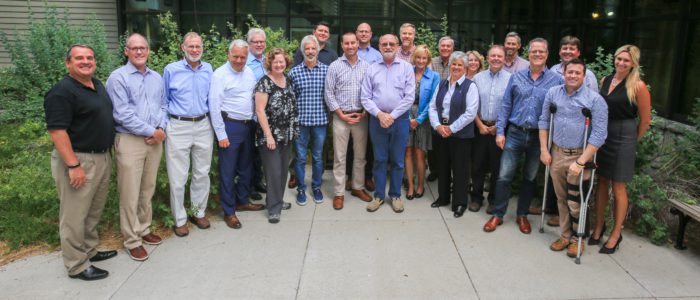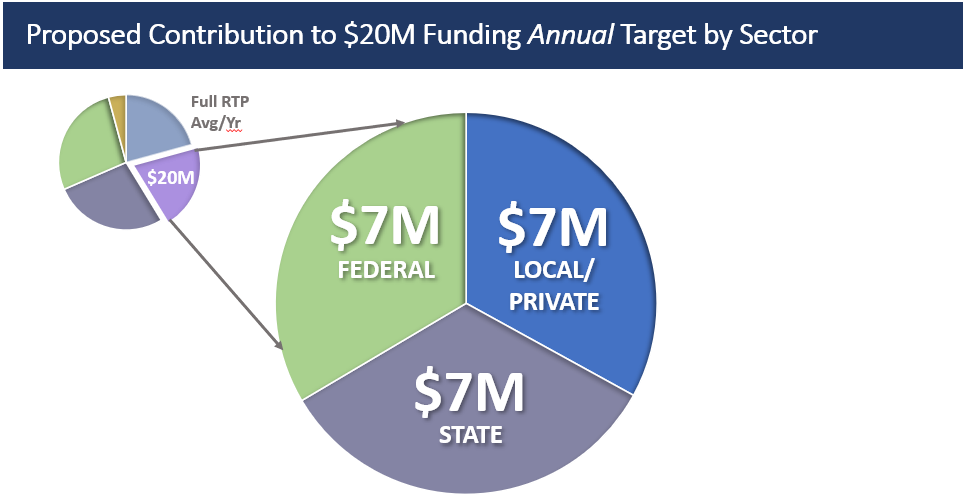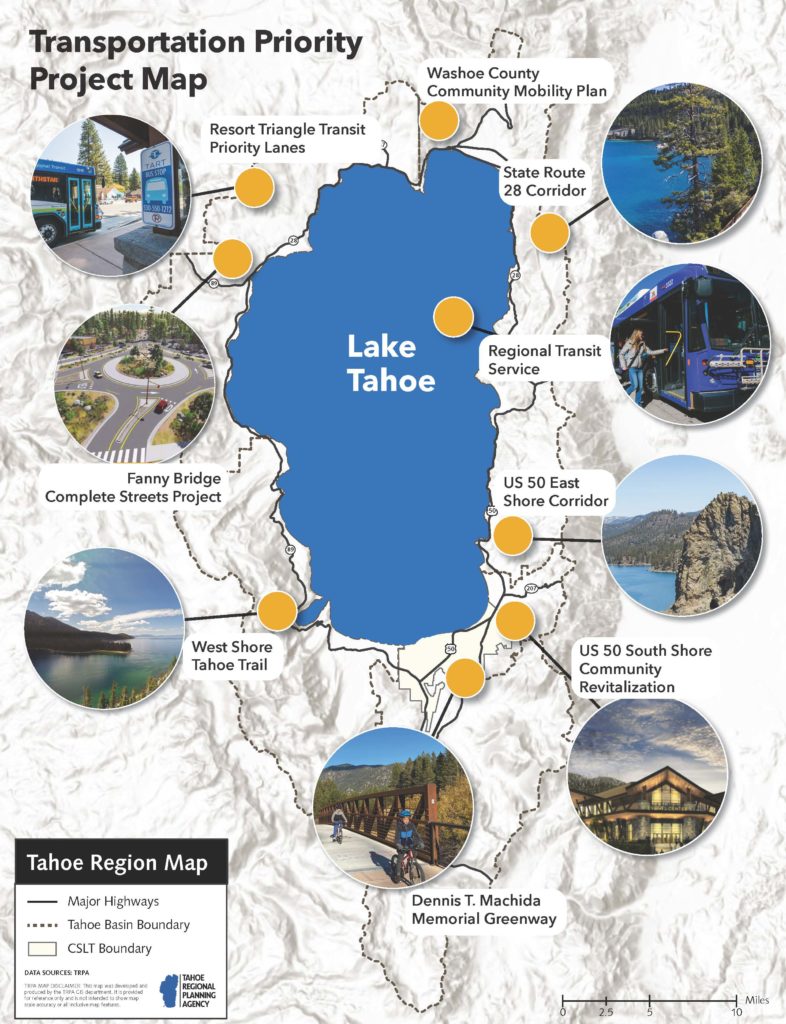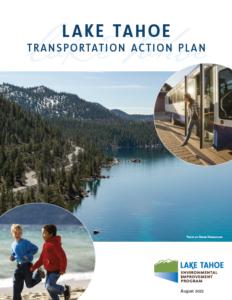Sustainable Transportation Funding Initiative
Lake Tahoe’s awe-inspiring environment has attracted visitors from across the globe and residents for generations. Today, its proximity to major metropolitan areas in northern California and Nevada make it a natural outdoor playground for the growing millions of people looking for unparalleled summer and winter recreation opportunities.
The 2020 Lake Tahoe Regional Transportation Plan is the region’s blueprint for a world-class transportation system. Unfunded priorities of the RTP total $400 million over the next 20 years, or a minimum $20 million annual gap in known revenue sources to achieve the desired RTP project priorities and benefits. Without this funding, the region will not be able to achieve the important goals set by the RTP or meet statewide priorities.

The Tahoe Regional Planning Compact directs Tahoe’s transportation programs to reduce dependency on the automobile. Since 2017, the Director of the Nevada Department of Conservation and Natural Resources and the Secretary of the California Natural Resources Agency have convened a Bi-State Consultation on Transportation for Lake Tahoe. The Bi-State working group brings together public and private sector partners to achieve needed transportation investment in the Tahoe Region.
Building on 25 years of success with the funding model of the Lake Tahoe Environmental Improvement Program (EIP), the working group agreed to pursue a shared multi-sector funding framework called the “7-7-7” strategy. Federal, state, and local/private partners would each seek to contribute $7 million per year from each sector for high priority, regionally significant transportation projects in the Region.
Accomplishments:
- Improved shuttle services and pilot “micro-transit” projects to reduce traffic congestion.
- New agreements between roadway agencies, land managers, law enforcement, and other key partners on managing Tahoe’s busy recreation corridors.
- Successful adoption of the 2020 Lake Tahoe Regional Transportation Plan (RTP) including new standards.
- Building consensus on regional priorities and funding strategies to deliver transportation investments.
Challenges
Lake Tahoe’s clarity and environment are threatened by vehicle impacts to the region including greenhouse gas emissions affecting climate change and roadway runoff degrading lake clarity.
Peak periods of congestion at popular recreation sites generates clogged roadways, inhibits equitable access, creates unsafe conditions for visitors, and hampers commuters during peak
seasons.
High local housing costs are pushing more of the workforce to reside outside the region constraining economic opportunity within the region. These pressures overwhelmingly impact the region’s most underserved community members.
Unfunded needs for priority projects total $400 million over the next 20 years, or a minimum of $20 million annually of new funding to achieve the desired Regional Transportation Plan project
priorities and benefits. Without this funding, the region will not be able to achieve the important goals or meet statewide priorities.
7-7-7 Strategy
The Bi-State Consultation working group met throughout 2021 to identify a strategy framework to meet the RTP’s unfunded $400 million gap, directing the work then to the policy boards of the Tahoe Regional Planning Agency (TRPA) and the Tahoe Transportation District (TTD), representing local elected officials, state appointees, private sector representatives, and the state departments of transportation to resolve details of the approach. These various bodies have been meeting frequently to arrive at consensus.

The Bi-State Consultation agreed that no single revenue option was feasible or sufficient to fully fund the $20 million annual revenue target. Building on 25 years of success with the Lake Tahoe Environmental Improvement Program (EIP), the working group developed a shared funding framework called the “7-7-7” strategy. Federal, state, and local/private partners would each seek to contribute $7 million per year for high priority, regionally significant transportation projects in the Region.

Bi-state partners have developed a suite of potential funding sources to meet funding needs to implement priority projects. The potential revenue sources are summarized below.
| Sector | ||||
| Local/Private | State | Federal | ||
| California | Nevada | |||
| Revenue Target | $7M | $4.5M | $2.5M | $7M |
| Potential Revenue Options | Zonal Congestion Management Fee | Direct budget appropriation | Environmental Improvement Program bonds | Increased formula funding |
| Local Taxes (sales, hotel, vacancy) | Use federal population for state formula funding allocations | Conserve Nevada Program | New funding programs | |
| Fees | Increased state support for existing & new competitive grant programs | Direct budget appropriation | Direct budget appropriation | |
| Increased general fund allocation | Increased state support for existing & new competitive grant programs | |||
Priority Projects
Tahoe partners have created an initial 10-year priority project list. Projects are organized within the focus areas below to create an innovative transportation system at Tahoe. Partners determined funding needs and priority project based on Lake Tahoe Basin plans, project lists, and regional importance. Each project directly addresses equity, environmental, economic, and climate goals.
| | Total Cost | Secured | Remaining Need |
| Transit | $ 574 M | $ 67 M | $ 507 M |
| Trails | $ 67 M | $ 3 M | $ 64 M |
| Technology | Integrated across all focus areas | ||
| Communities and Corridors | $ 291 M | $ 12 M | $ 279 M |
| Operations and Maintenance | $ 20 M | $ 5 M | $ 15 M |
| Totals | $ 952 M | $ 87 M | $ 865 M |
The 7-7-7 strategy and priority projects aim to fill the regional funding gap. Traditional funding sources will continue to be utilized to implement at wide variety of transportation project.
Priority Project Map

Transportation Action Plan

Lake Tahoe’s awe-inspiring environment has attracted visitors from across the globe for generations. Today, its proximity to major metropolitan areas in Northern California and Nevada make it a natural outdoor playground for the growing millions of people looking for unparalleled summer and winter recreation opportunities.
The Lake Tahoe Transportation Action Plan represents the region’s approach to funding and implementing the projects needed to create a world-class transportation system at Tahoe.
Measuring Success
The priority projects identified in the action plan will deliver on the ground results. They also contribute to the overall outcomes of the Regional Transportation Plan as a whole.
Equity and Access
Expand transit and trails to increase equitable access to recreation opportunities. Develop complete streets connecting housing to jobs and shopping for disadvantaged communities.
Climate
Protect and enhance the environment, promote energy conservation, and reduce greenhouse gas (GHG) emissions. Design infrastructure to be resilient to future climate impacts and support emergency evacuations during extreme events.
Environment
Reduce dependency on automobiles, reducing related transportation emissions and stormwater pollution. Maintain infrastructure to maximize environmental benefits.
Safety
Enhance safety for all, including along major highway corridors that have high levels of crashes and multiple fatalities.
Progress to Date
Federal sector: With the recent passage of the Investment Infrastructure and Jobs Act (IIJA) new funding is available through federal programs and congressionally designated spending to support regional priorities. These funds are a combination of formula and competitive grant programs that align well with regional transportation priority projects. These funding requests will require up to 20% non-federal (local and state) funding commitments as matching funds. The region has already seen new funding through the $2 million in congressionally designated spending on State Route 28, and additional requests are currently pending.
State sector: Both California and Nevada have been active in the identification of existing state programs and supporting new requests for additional funding. Their leadership with the Bi-State Consultation on Transportation has galvanized a shared regional funding framework that can leverage funding and position Tahoe as a priority for state and federal resources. Legislative and administrative pursuits for funding are underway in both states with a $22.5 million request pending in California and potential bond funding in Nevada under discussion.
Local/Private sector: Regionally significant transportation priorities that also support local Capital Improvement Programs (CIP) have been developed through basin-wide collaboration. The new local funding to support these projects varies and is the responsibility of each local jurisdiction. The regional momentum to deliver transportation solutions has resulted in local actions to advance new funding for communities around the region. An example is the recent passage of a 2% increase to Placer County’s Transient Occupancy Tax that would be available for transportation improvements in addition to the TOT already invested in transit and infrastructure projects by the County. Another funding option under consideration is a zonal congestion/parking fee for the recreation corridors on SR 28 in Nevada and Hwy 89 around Emerald Bay in California. The private sector continues to contribute to transportation solutions around the region. On the south shore, a diverse partnership of private partners has provided critical operating funding for a micro-transit service that will begin operation this summer. Additionally, TART Connect micro-transit has exceeded expectations in the North Shore.
Documents
- Transportation Action Plan
- Nevada Legislative Oversight Committee Report July 2022
- Revenue Options Briefing Book FINAL 05-19-22
- Sustainable Transportation Options Report FINAL 05-19-22
- One Tahoe Polling Results; source Cromer Group
- One Tahoe Appendix G
Background Data:
- Tahoe Trip Type and Origin – who is traveling to Tahoe and through which entry points; source TRPA Travel Demand Model
- Current Annual Funding – local transportation sources; source TRPA 2020 Linking Tahoe
- Policy Priority Survey – Regional Funding /& Governing & Administration results; source TTD and TRPA Board Members
